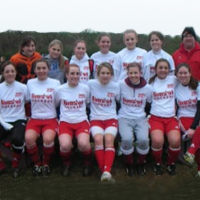I went into the Verizon Wireless store the other day, looking for an extra battery for what my daughter now tells me is a very old Razr. The Voyager caught my eye and I asked the velvet rope bouncer how it compared with an iPhone. It has a touch screen, he beamed. Ok.
One day this past week (I don’t know when and I forgot my password to get into WSJ.com, but that is another post!) they had a columnist write about how the Voyager looked cool, but it took 3-5 times more clicks to get to anything, the interface was different from application to application (phone, web browsing, contact book), etc, etc. As I read, it was clear that the voyager was no iPhone. What Verizon had apparently done was take the most obvious feature of the iPhone and slapped it on an old phone model. They put lipstick on a pig.
I find this being done a lot with soccer tournaments. A coach or a tournament director goes to another soccer tournament and sees something interesting being done, rushes home and immediately adopts this great new idea. Most of the time, it doesn’t work as successfully at home as it did at the other tournament. So, it must be a failure. But not really.The reason the idea worked over there but not here is because the other soccer tournament didn’t start out with a pig. The red, rosy lips were real, not just lipstick covering up a problem. Their pig is their culture, part of who they are. The rosy lips is a manifestation of that culture, not just makeup.
As with the iPhone, the touch screen works because it is an extension of Apple’s culture of the computer working as an extension of the body. For example, their culture includes a vocabulary like files and folders, calendars and drawing tools.. not directories, databases and input devices. The touch screen on the iPhone is the next 2 millimeters of the human fingers, not the clunky push-dial of a computer. Entirely different.
Our advice: The next time you see a great idea being implemented at another tournament you visit — before you become convinced that it is something that you should also implement — examine why it works, not just how. Perhaps the volunteer system works because the club has a large population of Red Cross volunteers, not because they have a great volunteer management software package. Or, perhaps the advertising program works because the there is a large population of brand managers of a CPG company whose kids all play in the same club, not because their printed program looked cool.
And the same goes for tournament management software, like TourneyCentral.com. The stuff works because it is meant to manage soccer tournaments, not just some scheduling software that got draped with some soccer ball clip art. It works because it addresses the needs of the parents and players attending your soccer tournament. It works because the people at TourneyCentral understand the needs of the soccer tournament director, their teams, their parents and their sponsors.
 WEST CARROLLTON – The road led directly to Rome, GA for one local soccer team this past weekend. The Southstars Rockers, based in West Carrollton, participated in the Girls 19 division at the Sport Source Junior-Senior Showcase. The girls ended up with a 1-0-2 record at the end of the weekend.
WEST CARROLLTON – The road led directly to Rome, GA for one local soccer team this past weekend. The Southstars Rockers, based in West Carrollton, participated in the Girls 19 division at the Sport Source Junior-Senior Showcase. The girls ended up with a 1-0-2 record at the end of the weekend.